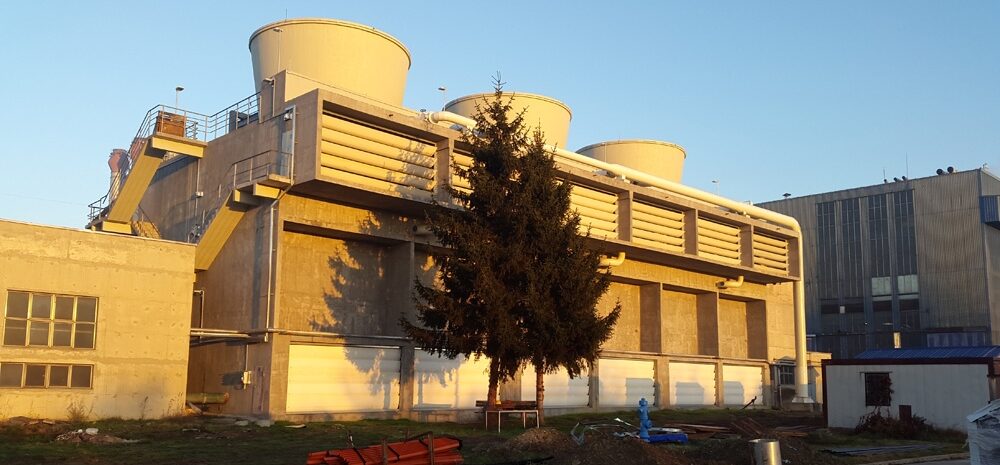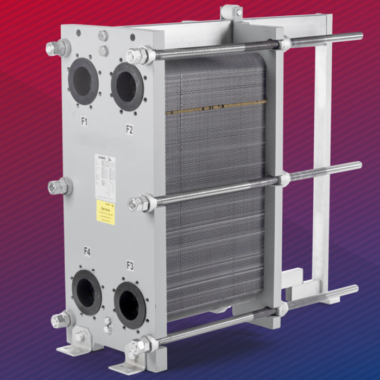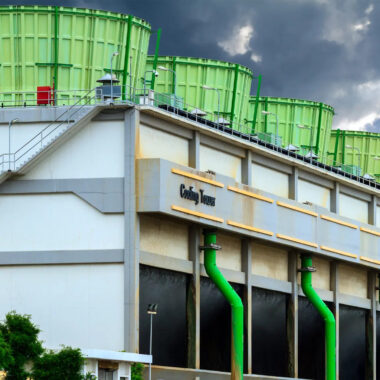Eco-Friendly Cooling Towers
Introduction
Eco-Friendly Cooling Towers are transforming the industrial landscape by integrating sustainable technologies that prioritize environmental preservation and resource efficiency. These advanced cooling systems are designed to minimize water usage, reduce energy consumption, and lower emissions, making them ideal for industries striving to meet modern sustainability standards.
Key Eco-Friendly Technologies in Cooling Towers
- Hybrid Cooling Systems
- Overview: Hybrid cooling towers combine the benefits of both wet and dry cooling systems. By alternating between air and water cooling depending on environmental conditions, hybrid systems can significantly reduce water usage while maintaining efficiency.
- Benefits: Lower water consumption during cooler periods, reduced environmental impact, and increased operational flexibility.
- Low-Noise Fans
- Overview: Modern cooling towers are equipped with energy-efficient, low-noise fans that minimize sound pollution while optimizing airflow and reducing power consumption.
- Benefits: Quieter operation, lower energy bills, and compliance with noise regulations.
- Water Conservation Technologies
- Overview: Technologies such as high-efficiency drift eliminators and water recirculation systems reduce water loss and optimize water use within the cooling tower.
- Benefits: Significantly reduced water wastage and better water management, crucial for areas with limited water resources.
- Natural Draft Cooling Towers
- Overview: Natural draft cooling towers rely on the natural rise of warm air and gravity to facilitate cooling, without the need for mechanical fans or pumps. These towers can operate with minimal energy input.
- Benefits: Reduced energy consumption and operational costs, making them ideal for energy-conscious industries.
- Green Materials
- Overview: Eco-friendly cooling towers are constructed using sustainable and recyclable materials such as fiberglass-reinforced plastic (FRP) or high-performance composites that resist corrosion and extend the lifespan of the tower.
- Benefits: Reduced environmental impact during manufacturing and longer operational life, leading to fewer replacements and less waste.
Benefits of Eco-Friendly Cooling Towers
- Reduced Carbon Footprint
- Overview: By using energy-efficient technologies and reducing reliance on water, eco-friendly cooling towers contribute to a lower overall carbon footprint.
- Impact: Helps industries meet stricter environmental regulations and promotes sustainability efforts.
- Cost Savings
- Overview: The implementation of energy- and water-saving technologies leads to long-term cost savings through reduced operational expenses and lower resource consumption.
- Impact: Higher initial investments in eco-friendly systems can be offset by significant savings over the lifespan of the cooling tower.
- Compliance with Environmental Regulations
- Overview: Eco-friendly cooling towers help industries stay compliant with local and global environmental regulations by reducing emissions, conserving water, and minimizing waste.
- Impact: Avoidance of fines, improved corporate reputation, and contribution to global sustainability initiatives.
- Enhanced Operational Efficiency
- Overview: Sustainable technologies, such as hybrid cooling systems and water conservation features, optimize performance and efficiency while reducing resource dependency.
- Impact: Higher cooling capacity, more stable operations, and reduced maintenance requirements.
Challenges and Considerations
- Initial Cost
- Overview: The upfront cost of implementing eco-friendly cooling technologies can be higher than traditional systems, particularly when incorporating advanced features like renewable energy integration.
- Consideration: Businesses must assess the long-term benefits and return on investment, as eco-friendly systems often pay for themselves through operational savings.
- Technological Maturity
- Overview: Some sustainable technologies are still emerging, and industries may need to carefully evaluate their performance and reliability before large-scale adoption.
- Consideration: Research and case studies on existing installations can provide valuable insights into the effectiveness of these systems.
- Customization for Specific Environments
- Overview: Different industries and climates require tailored eco-friendly cooling solutions to address unique challenges such as water availability, temperature extremes, and environmental regulations.
- Consideration: Collaboration with cooling system manufacturers to design and implement customized eco-friendly towers for specific applications.
Conclusion
Eco-friendly cooling towers represent the future of industrial cooling by embracing sustainable technologies that reduce water consumption, energy use, and carbon emissions.Welltech Cooling Towers is committed to providing innovative, sustainable cooling technologies that help industries reduce their environmental impact while maintaining efficient operations.







Zero-Liquid Discharge Cooling Towers - Cool Fab Equipments September 23, 2024 at 10:48 am
[…] Zero-Liquid Discharge cooling towers are designed to address the growing concerns over water scarcity and environmental impact by eliminating wastewater discharge from cooling processes. Traditional cooling towers rely on a continuous supply of water for evaporation and use blowdown to remove dissolved solids, which leads to significant water loss and environmental concerns. ZLD systems, however, employ advanced technologies to recycle and reuse the water within the cooling tower, leaving behind no liquid waste.Eco-Friendly Cooling Towers […]